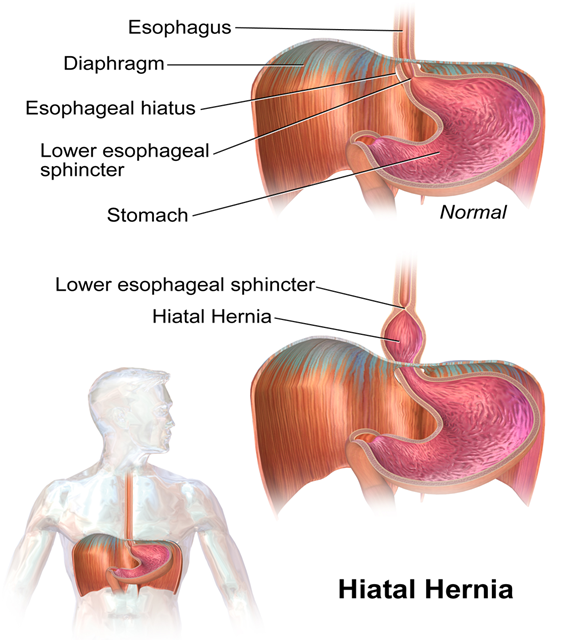Page Contents
What is Hiatal hernia?
Generally, the oesophagus or food pipe is the path to connect the throat to the stomach. The food moves from throat to stomach through oesophagus, passing through the chest and ending up in the abdomen. Below the lungs, the diaphragm is present to help in respiration, and the stomach is located just below this diaphragm. So the food pipe passing through a hole in diaphragm to transfer food in the stomach. This hole is called as oesophagal hiatus.
Hiatal hernia is a medical condition wherein the upper portion of the stomach pushes itself through oesophagal hiatus to stay in the chest area.
Symptoms:
- Some people may not observe any symptoms, but some may feel the following:
- Difficulty in swallowing
- Pain in Chest
- Frequent Bloating or burping
- Heartburn due to GERD (gastro-oesophagal reflux disease)
- Trouble while breathing
- Vomiting or upset stomach
- Unable to defecate or fart
- Blood in vomit
- Passing bowels with the presence of black color that indicates internal bleeding
It is suggested not to neglect any of the above symptoms and consult with an expert, who can provide an analysis of the exact situation.
Causes
- Large Hiatal opening from the time of birth
- Changes in diaphragm with age
- Pressure in the belly due to coughing, obesity, pregnancy, weight lifting, etc.
- Stomach injury
- The weakening of muscles in the area
- Smoking
Diagnosis
As most of the times, patients suffering from hiatal hernia don’t show symptoms or their symptoms seem to be similar to other medical problem. Hence proper diagnosis is essential to detect the root cause. If you are looking for the treatment or any advice, then consider consulting Dr Ashish Bhanot. He has cautiously handled similar cases in his career with successful results. For clarity on the situation, the medical practitioner may advise undergoing through the following test:
- X-ray of the upper portion of the digestive system: To identify the shape, figure or track of oesophagus, stomach & intestine, the person needs to drink a liquid which can coat and fill the internal lining of the digestive tract.
- Endoscopy: In this process, the endoscope is inserted down the throat to observe the condition of the food pipe and stomach from inside. An endoscope is an equipment that has light and camera and is thin and flexible in shape.
- Oesophagal manometry: This is to record the muscle contraction, force, and coordination in the oesophagus while swallowing food.
Treatment
Hiatal Hernia can lead to many complicated problems. Therefore, it is essential to take medical advice as soon as possible. The treatment procedure depends on the complexity of the case.
Below are some of the treatment procedures which the doctor may suggest.
- Medication
In the case of acid reflux or heartburn, at first, you may be recommended to take some medicines. These include antacids to neutralize acid secreted by the digestive glands of the stomach. To lower down or prevent acid production, some oral medications may be prescribed to give time for the oesophagus to heal.
- Surgery
In case the prescribed medication does not show improvement in the condition, then there is a chance that surgery will be suggested.
Know More – Cataract Surgery Facts to Clear Your Vision
Two different approaches can be followed in surgery to treat this medical condition.
- First can be to rebuild the weak muscles of the oesophagus
- Placing the stomach to its position and making the opening of hiatus smaller
For performing this surgery, the surgeon may insert a tiny camera with other required surgical tools with the help of many small slits in the abdomen. This will help the doctor to see the inside view on the monitor and known as laparoscopic surgery.
Sometimes the complete surgery is performed using a single opening in the chest wall and known as thoracotomy. So book your appointment for Hernia treatment in Delhi today and get expert advice.
But this problem can occur again after surgery so it is advised to take care of the health after surgery too. Maintain the BMI of the body and avoid lifting heavyweights. Also, try not to put pressure on abdominal muscles.
Also, the patient has to pay more attention to health and lifestyle. It is recommended to avoid spicy food, chocolate, caffeine, onions, alcohol, and citrus fruits as they increase acid production.





